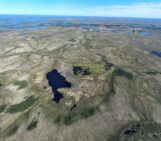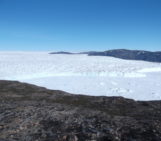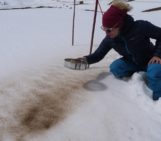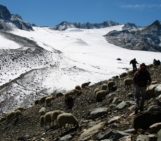
“Peak snow accumulation” in 2015 at the Phillips snow course, California Sierra Nevada. In the middle, behind the podium, is none other than Jerry Brown, Jr., then Governor of California [Credits: California Department of Water Resources]
1 April 2015: for the first time on record, the chief of the California Cooperative Snow Surveys, Frank Gehrke, had no snow to measure at the Phillips Snow Course near Lake Tahoe at the end of the winter. This was in some ways unsurprising, as California had been in a drought since 2012. But drought was nothing new in the state, and this was the first time on record that snow was completely absent on this critical date. In the years since 2015, scientists have worked to pinpoint what was so exceptional about that year, and the answer tells us a lot about how the future cryosphere will look and what the implications are for water supply, the economy, and policy. In short, it tells us where the geosciences will need to focus in the coming decades: finding solutions to society’s most fundamental challenges.
Less snow, more rain
Water supply (or lack thereof) was a constant talking point all across California during the 2012–2016 drought. But as severe as the drought was, total precipitation in the river basin around Lake Tahoe, where Gehrke was measuring snow, was still 80% of average — not as low as you might expect during a drought. Instead, what made the situation so damaging (in this part of the state at least) was that much less of the precipitation had fallen as snow than normal. This shift from snow to rain led to the unprecedented conditions at Phillips Snow Course, a foreshadowing of the challenges that California will face as the climate continues to change.
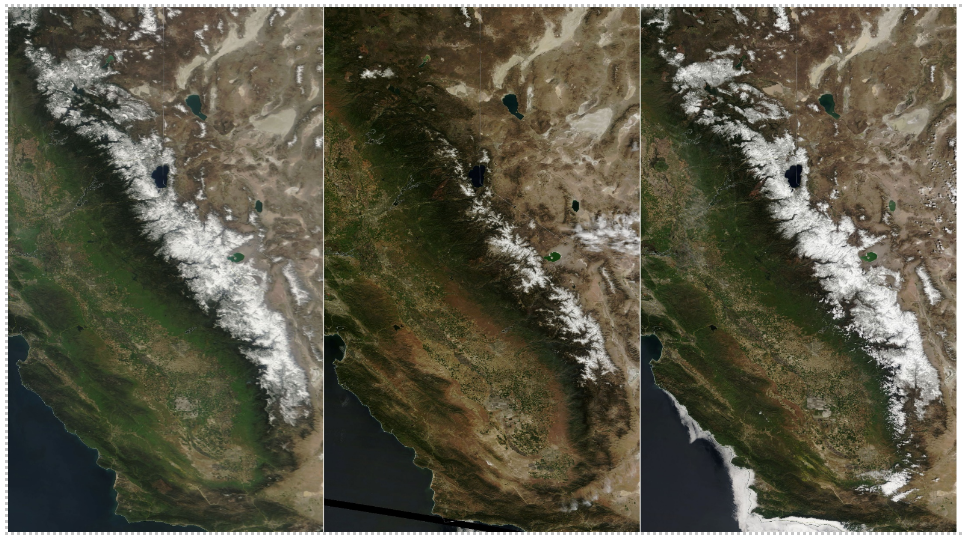
A very good illustration of the 2015 shift from snow to rain: peak-snow accumulation across the California Sierra Nevada in 2010 (left, pre-drought), 2015 (peak of the drought), and 2017 (post-drought). [Credits: EOSDIS Worldview].
Ultimately, it’s still water, right?
You may ask why this change from snow to rain is so important. The issue is that most of precipitation in the Western US falls during the winter months. Having the ability to store this winter precipitation and use it up over the course of the dry summer months is critical to the way California’s economy has been designed. Indeed, the Californian water-distribution network moves freshwater for hundreds of miles from the snowy Sierra Nevada down to the agricultural Central Valley, the San Francisco Bay Area, and the metropolitan areas of Southern California. And while the US is seemingly a land of dams and reservoirs, artificial lakes can only capture a small fraction of winter precipitation. So, the snowpack itself has traditionally been used as natural storage, its slow melt allowing agencies to send water deliveries incrementally over the course of weeks and months across the state. If more of that snow falls as rain, reservoir operators may have no choice but to release it, unused, even in a drought — they simply have no place to put it!
It’s not just human infrastructure that is threatened by loss of snowpack. Less snow during the drought meant earlier melt out, which in turn reduced the water available in the natural environment during the dry Californian summer. The interplay between the drought and a gradual shift from snow to rain also caused a jump in state-wide tree deaths, set the stage for some of the most devastating wildfires on record, and resulted in yet another prolonged period of unsustainable groundwater use.
The bottom line is that the seasonal melt of snow in California is critical to supporting the state’s ecosystem services, its national parks, 40 million people, $3.2 trillion economy, and 25.3 million acres of agricultural land producing about 50% of US fruits and vegetables. A shift from snow to rain — compounded with a drought year like 2015 — is not only a landscape issue, but also a water, food, and national-security issue.
It’s getting hot in here
So why is California losing its snow? This widespread lack of snowpack during the 2012-2016 drought was driven by unusually high winter temperatures. This is not to say that lower precipitation during the drought was irrelevant, but it’s striking that the northern part of California and the Pacific northwest saw even above-average precipitation in 2015 despite a widespread lack of snow. And unfortunately for California, climate change means those warm winters are in the forecast for the future too.
It’s as if snow is a savings account Californians have opened with mother Nature. That account is starting to run dry, and climate change is likely to drive the balance even lower in the 21st century. But interestingly, earth-science researchers may be the ones that help balance the water books.
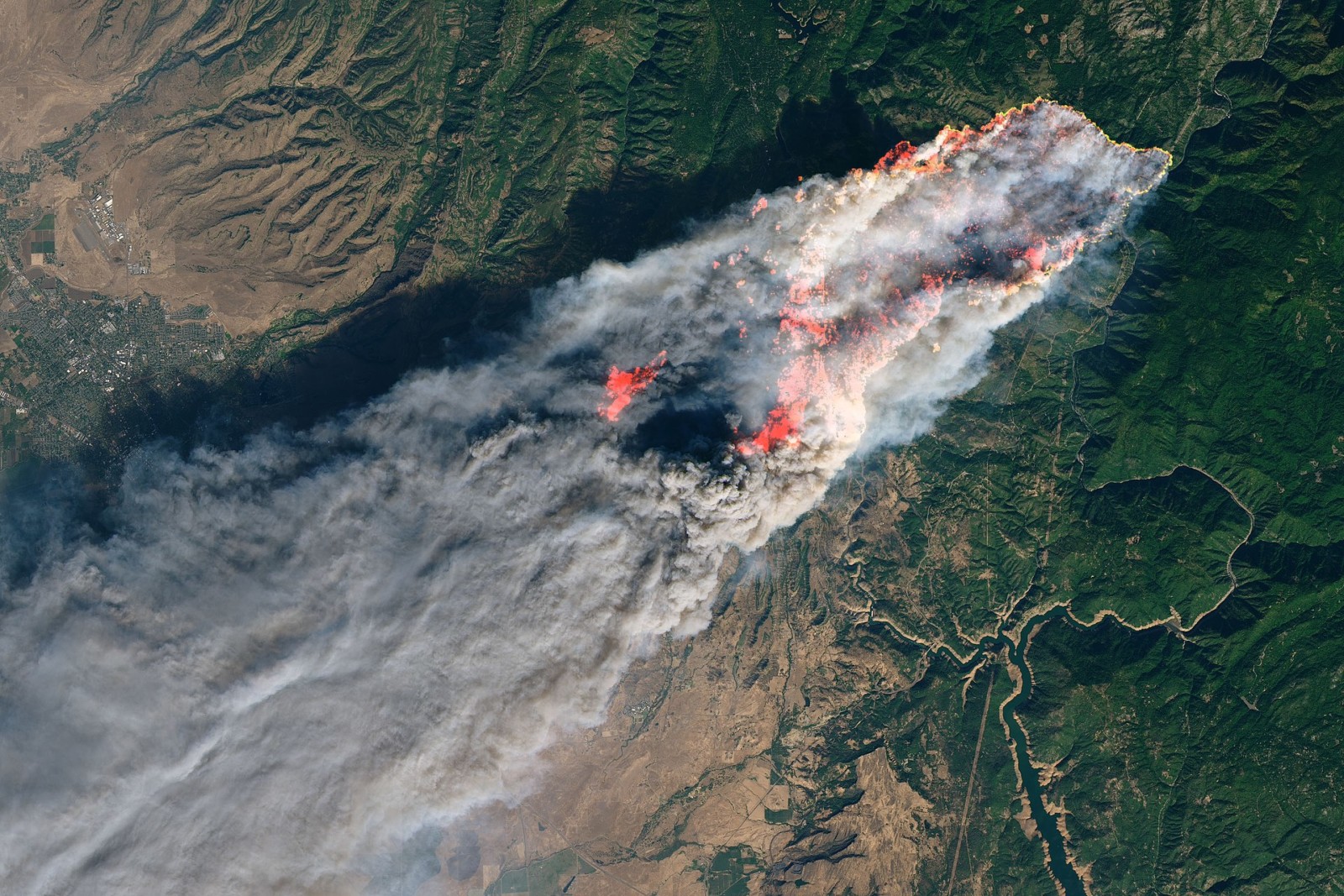
The Camp Fire in northern California, November 2018. The final extent was about 62k ha, or 620 km2 [Credits: NASA Earth Observatory]
Making up for the lost snow
The recent drought was not passed up as a learning opportunity for science and policy researchers to begin to get a handle on this challenge. Plenty of research has investigated the science of the drought — its origins, implications, and paleo-historic context. However, emphasis is also now being given to adapting modern water systems to climate change — in particular those systems relying on snowmelt and vulnerable to shifts from snow to rain.
We both worked on one such initiative, the Feather River Hydrologic Observatory, a collaboration between our research group at the University of California (Berkeley & Merced), Pacific Gas & Electric (PG&E — one of the largest energy companies in the US), the California Department of Water Resources (DWR), and the California Energy Commission. We started by spending a couple of summers up in the Sierra Nevada mountains installing new-generation sensors in the area where PG&E has the bulk of its hydropower plants. These sensors were organized in clusters to sample snow across the landscape: open meadows and dense forest, flat fields and steep ravines, mountain slopes that face north and get less sunlight and mountain slopes that face south and get much more. These data were transmitted in real time, so we could collect information even in the winter when the sites were inaccessible. We then used these data together with machine learning to develop maps of snow distribution and, in turn, improve the predictions of one of the tools that PG&E uses to forecast water supply (a snow-hydrologic model called PRMS). In the cool video below, you can see one of the sensor clusters we installed in northern California. The map in the bottom-left corner is a schematic of the cluster across the landscape [Credits: Dr. Thomas Watteyne and the SNOWHOW team].
This is only one example out of dozens. Others include projects geared toward designing optimal “groundwater-banking” techniques, that is, methods to divert excess water from rivers into the ground and so replenish the other major storage site that is naturally available in California (remember we said storage is critical?). Another involves changing how we manage forests to reduce the risk of fires and tree mortality, while also increasing water availability for downstream ecosystems and urban centers.
The 2012-2016 drought, in the context of a long-term warming climate, also saw a push to bring together scientists, decision makers, and private stakeholders. The peculiar challenge of a warming climate has required these groups to develop a common vocabulary to tackle current and future water challenges across the state and synchronize their agenda for the years to come.
Ultimately, for many of us, the drought was a call to broaden our research focus from purely curiosity-driven to solution-oriented questions. This shift in thinking promises to bear fruit for decades to come.
Hey you, early-career scientist!
“Decades to come” may sound like wishful thinking for those early-career scientists struggling to earn their degree and then finding their way through the job market (uncertain at the best of times, truly precarious in a pandemic). Because both of us are early career scientists (Francesco finished a post-doc in 2019, while Tessa received her doctorate in 2020), we thought we could share some lessons we learned from this experience.
First, both of us found that the job market is widening and more posts in applied science are being created every day. For example, Tessa is now a scientist at Blue Forest Conservation, a non-profit creating sustainable financial solutions to meet pressing environmental challenges in forest management, while Francesco is a researcher at CIMA Research Foundation, an applied-research center where he focuses on understanding and forecasting hydrologic risks in mountain regions. Many of our colleagues found jobs as data scientists or project engineers, and companies are starting to see a PhD as a real added value for many positions.
Second, unprecedented opportunities exist for researchers to engage with decision and policy makers, as well as the general public, to find solutions to real-world problems. This implies training ourselves to seek science that is not only “interesting”, but also “relevant”. Curiosity-driven research is certainly important, but the world now increasingly needs solutions. This also requires us to improve how we explain our science to non-scientists, in order to make an impact on real-world policies. Science communication skills are key. And if not early-career scientists making these connections, then who else?
Third, listening to our private and public partners was way more effective than disseminating our results. In other words, doing solution-oriented research benefits from a two-way communication based on listening what and where the actual problems are and what we can do to help, rather than only telling the world about our new findings. Not to say that journal papers and the like are irrelevant, but we must take extra steps if we want our research to actually help solve problems.
Fourth, while we used remote sensing and models, going up to the mountains and seeing how things worked firsthand undoubtedly added value. Include field work in your portfolio if you can.
And finally: solutions-oriented science is almost always interdisciplinary (across different sciences, across different academic fields, across different regions, and across the academic-industry divide). Like Frank Gehrke, who engaged with the public to the point of convincing the state press to climb the mountains every year to literally just see how much snow was on the ground, researchers should get used to breaking out of traditional silos. Building these connections can be particularly useful for early career scientists looking for jobs in a global market: the challenges related to warming mountain regions, for example, are common across the world. In Europe, a recent study shows that water supply from glaciers currently compensates for dry, warm periods – but how long will this last in a warming climate?
Maybe, we’ll need to look to California for answers.

The team installing one sensor across the beautiful landscape of the Feather River basin in northern California. Part of our networks was burnt down by wildfires in 2020, another reminder that the 2012-2016 drought may be over, but many of its challenges are still with us [Credits: Francesco Avanzi]
Edited by Andy Smedley
 Francesco Avanzi is a researcher at CIMA Research Foundation and was previously a postdoctoral scholar at the University of California, Berkeley. At CIMA, he works on the cryosphere-research portfolio. His activities include mountain hydrology and the cryosphere, with a particular interest in developing operational water-forecasting models for cryosphere-dominated regions. He tweets as @WorldOfChecco. Email contact: francesco DOT avanzi theATsign cimafoundation DOT org
Francesco Avanzi is a researcher at CIMA Research Foundation and was previously a postdoctoral scholar at the University of California, Berkeley. At CIMA, he works on the cryosphere-research portfolio. His activities include mountain hydrology and the cryosphere, with a particular interest in developing operational water-forecasting models for cryosphere-dominated regions. He tweets as @WorldOfChecco. Email contact: francesco DOT avanzi theATsign cimafoundation DOT org
 Tessa Maurer is a Senior Project Scientist at Blue Forest Conservation and holds a PhD in water resources from the University of California, Berkeley. Her work at Blue Forest involves quantifying the multiple environmental and socio-economic benefits of sustainable forest management work as well as engaging beneficiaries of that work to accelerate the pace and scale forest restoration in the Western US. Her Instagram alter-ego, a sewer rat named Jean-Jean (@jjsewerat), posts about the importance of maintaining and appreciating our water infrastructure. Email contact: tessa@blueforest.org
Tessa Maurer is a Senior Project Scientist at Blue Forest Conservation and holds a PhD in water resources from the University of California, Berkeley. Her work at Blue Forest involves quantifying the multiple environmental and socio-economic benefits of sustainable forest management work as well as engaging beneficiaries of that work to accelerate the pace and scale forest restoration in the Western US. Her Instagram alter-ego, a sewer rat named Jean-Jean (@jjsewerat), posts about the importance of maintaining and appreciating our water infrastructure. Email contact: tessa@blueforest.org
We are grateful to all colleagues working with us on this project, including Dr. Sami Malek (UC Berkeley), Prof. Steve Glaser (UC Berkeley), Prof. Roger Bales (UC Merced, UC Berkeley), Prof. Martha Conklin (UC Merced), Kevin Richards (PG&E), Dr. Peter Hartsough (UC Davis), Robert Taylor (UC Davis), and many others.

